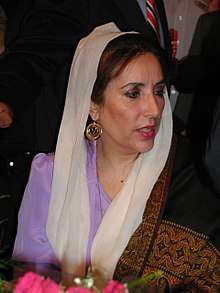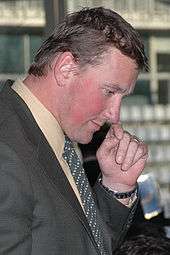St Catherine's College, Oxford
St Catherine's College (also known as St Catz or Catz) is one of the constituent colleges of the University of Oxford in Oxford, England and is the youngest college to teach both undergraduate and graduate students.[3] Tracing its roots back to 1868 (although the college itself was opened in 1962), it has 505 undergraduate and 442 graduate students as of December 2018,[4] making it the largest undergraduate college by membership in the University of Oxford (Kellogg College has 1139 students compared to St. Catherine's 992, though it is a graduate-only college).[4] In 1974, it was also one of the first men's colleges to admit women.[5]
| St Catherine's College | ||||||||||||||||
|---|---|---|---|---|---|---|---|---|---|---|---|---|---|---|---|---|
| Oxford | ||||||||||||||||
.svg.png) Blazon: Sable a saltire ermine between four catherine wheels or. | ||||||||||||||||
| Location | Manor Road | |||||||||||||||
| Coordinates | 51.757066°N 1.245098°W | |||||||||||||||
| Motto | Nova et Vetera (The New and the Old) | |||||||||||||||
| Established | 1962 | |||||||||||||||
| Named after | St Catherine of Alexandria | |||||||||||||||
| Previous names | Delegacy of Unattached Students, Delegacy of Non-Collegiate Students, St Catharine's Club, St Catherine's Society | |||||||||||||||
| Architect | Arne Jacobsen | |||||||||||||||
| Sister college | Robinson College, Cambridge | |||||||||||||||
| Master | Kersti Börjars | |||||||||||||||
| Undergraduates | 505[1] (December 2018) | |||||||||||||||
| Postgraduates | 428[1] (December 2018) | |||||||||||||||
| Endowment | £88.2 million (2019)[2] | |||||||||||||||
| Website | www | |||||||||||||||
| Map | ||||||||||||||||
 Location in Oxford city centre | ||||||||||||||||
The college developed out of the university's Delegacy for Unattached Students, and was founded in 1962 by the historian Alan Bullock, who went on to become the first master of the college, and later vice-chancellor of the university. The current master is Kersti Börjars, who took over the role in 2020 and is also the college's first female master.
History
The college traces its descent from the Scholares Non Ascripti, or Delegacy for Unattached Students, founded by Statute on 11 June 1868.[6] Created in response to the recommendation of a Royal Commission in 1852, this was established as part of an expansion of the university so that male students would be able to gain an Oxford education without the costs of college membership.[7] The college therefore celebrated its 150th anniversary in the academic year 2018–2019, coinciding with the 2018 Ball 'Continuum'. The College itself celebrated its 50th anniversary in 2012.[8][9]
The delegacy was originally headed by two Censors, George Kitchin and George S. Ward, who oversaw the administration and welfare of the students.[10] Nineteen students matriculated in October 1868 as Scholares Non Ascripti and were joined throughout the year by another forty, bringing the total number in the first year to fifty-nine.[11] By 1914, more than 4,000 men had matriculated as non-collegiate students.[12] In 1884, the delegacy was renamed the "Delegacy for Non-Collegiate Students".[7] Due to the lack of an identifying name for social and sporting purposes, groups identified with the delegacy began using the name "St. Catharine's", taken from a hall used for boat club meetings on Catte Street.[13] In 1931 the delegacy was officially renamed the "St. Catherine's Society", with the spelling changed to "St. Catherine's". This name is also a reference to St. Catherine of Alexandria; this can also be seen in the college blazon, which depicts four Catherine wheels, one of St. Catherine's attributes. The society was thus developing the characteristics of a college, and in 1956 the delegates decided to formalise this change in status by obtaining approval to turn into a fully residential college.[14]
After acquiring 8 acres (3.2 ha) from Merton College, Oxford on part of Holywell Great Meadow for £57,690, monies were sought from the University Grants Committee who also agreed to supply £250,000 towards the building, and additional funds up to £400,000 for all facilities. By 1960 Sir Alan Bullock raised a further £1,000,000 with invaluable assistance from two industrial notables, Sir Alan Wilson (whom he met by chance on the RMS Queen Mary) and Sir Hugh Beaver. After a total expenditure of £2.5 million, the college opened in 1962. In 1974, St Catz was one of the first men's colleges to admit women as full members, the others being Brasenose, Jesus College, Hertford and Wadham.[15]
Buildings

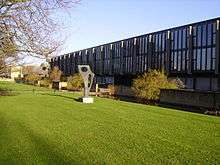
Original buildings
The college is located to the east of central Oxford, on the banks of the Cherwell. Its buildings in glass and concrete, by the Danish architect Arne Jacobsen, marry modern materials with a traditional layout around a quadrangle. Jacobsen's designs also included cutlery, furniture, and lampshades. The dining hall is notable for its Cumberland slate floor.
The original college buildings received a Grade I listing in 1993.[16] Jacobsen's plans for the college did not include a chapel, which is unique among most Oxford colleges: St Cross Church on the corner of Manor Road and Longwall Street served this purpose before its decommission in 2008. The St Catherine's Christmas carol concert is now held in Harris Manchester College's chapel. The college has a bell tower, particularly visible since no college building is more than three storeys high. An extra floor was reputedly planned for most accommodation blocks, but due to regulations concerning safe building on marshland, this was removed from the final design.
St Catherine's has a number of lecture theatres and seminar rooms, a music house, two student computer rooms, a small gym, squash courts, a punt house, and among the most spacious common rooms in Oxford. There are also additional purpose-built conference facilities with lecture theatres, meeting rooms and bar, music room, and car parking available for non-students. The dining hall, which seats 350 diners, has the largest capacity of any Oxford college.[17]
St Catherine's also has a library with over 55,000 volumes, which is used mainly by undergraduates in all the disciplines taught at the college, as well as 14 computer terminals.[18] The college lending library supplements university libraries, which are usually non-lending.[19] Law students have additional resources located in the college law library, which is located in the Bernard Sunley building.[18] Most tutorials are carried out in college, though some undergraduates may be sent to other colleges. For additional resources, the college is located next to the Social Science Library, Oxford and Faculty of Law, University of Oxford, which matriculated students are free to use.
The majority of St Catherine's buildings are in the form of staircases that open directly onto the quad(s) outside; these are filled with student rooms and office space. There is little indoor space in the college and St Catherine's favours a minimalist, rather austere environment, though still comfortable. Student rooms are light and spacious, notable for their curtain wall glazing.
1994 and 2004 extensions
In 1994 and 2004, the college completed construction of three and seven new accommodation staircases designed by Hodder and Partners with en-suite rooms, which means that most undergraduates can live on the main college site for the duration of their course. Prior to this, all undergraduates had the experience of living off-campus for their second year. These new staircases effectively form a second quad called 'New Quad' (in comparison to the Jacobsen-designed 'Old Quad'), which is largely used to provide accommodation for conferences during the breaks between academic terms.
Graduate building
Plans were announced in 2017 to construct new graduate facilities by Purcell Architects. The facilities aimed to resemble Jacobsen's original designs and was built on the college's last available development space.[20] The Ainsworth Graduate Centre is named in honor of Roger Ainsworth, the previous Master of the college. Construction started in July 2018, with the centre opening in March 2020. The centre includes seminar rooms and space for academic works. It also expanded graduate accommodation by creating three new staircases, which contain 78 single rooms with en-suite facilities and a new common room.[21] This is in addition to 42 single rooms, with shared bathroom and cooking facilities, in St. Catherine's House, which is located off-site on Bath Street.[22]
Student life
St. Catherine's has one of the largest undergraduate and graduate intakes among Oxford colleges, admitting 215 graduate students in the 2018-2019 academic year.[22] There is a college bar, as well as a Junior Common Room (JCR) and a Middle Common Room (MCR), which was relocated to the Ainsworth Graduate Centre in 2020 (it was previously located in the Bernard Sunley building).
The JCR is run by a committee of 25 undergraduate students, led by the President and elected by the rest of the student body through 'hustings', or a general Q&A (question and answer) session. The committee fulfills a wide range of duties, aimed at organising events, such as Freshers' Week, and providing support to the students. Open meetings are held fortnightly, during which people discuss how to improve the JCR. All undergraduate members are automatically members of the JCR, unless they expressly state that they wish not to be. Honorary membership is also rarely extended to others, with one awarded every five years: honorary members include Robbie Williams and Bradley Walsh.[23][24][25] The Catz JCR is notably financially independent from the College, following a financial committee meeting.[26] Similarly, the MCR is composed of graduate students, visiting postgraduate students, fourth-year undergraduate students and mature (over the age of 21) full-time undergraduate students, who also have JCR membership. It is run by a committee led by two co-presidents, which organises several events such as an annual garden party. The MCR also has benefits, such as a separate kitchen and the exclusive use of an enclosed garden.[27][28]
The college celebrates its patron saint each year with a special Catz Night dinner, attended by junior and senior members of the college. Every three years the college also holds a ball, usually off-site due to the problem of securing the college's perimeter sufficiently for insurance purposes. St. Catherine's is also known for its more modern approaches, such as by not requiring students to wear formal dress for dinners and voting to end the tradition of standing when the Master enters the hall at formal dinner,[29] although most students still continue in this practice out of respect. The College also holds fortnightly social events called 'Entz', which are usually themed and hosted in the JCR and bar, and an annual Catz Artz Week which showcases creative talents.[30]
The college also has several sport, music and other facilities available on the college site, including squash courts, pool tables, a free gymnasium, a punt house, and theatres.[22] The music house on site is equipped with a grand piano and harpsichord. There are also several clubs and societies available, such as the music society, orchestras, choirs, and subject societies.[31] The dramatic society often performs plays and musicals, including recent adaptations of Rent and Chicago.[32] St Catz has a friendly college rivalry with Magdalen, expressed in sports and in a joke JCR 'declaration of war' in 2013.[33]
Accommodation
The college is able to offer three year accommodation for students, with all first years on site.[34] Most first and third years live in the Jacobsen-designed 'Old Quad', the original buildings, while the second years live in the 'New Quad', built during the 1995–2005 extensions. There is a kitchen in every corridor, generally shared between eight to ten people. Bathrooms containing four showers and two toilets are shared between groups of ten people in the Old Quad, while every bedroom in the New Quad is en-suite. Rooms are allocated randomly for first year students, while groups of four to six students in second and third year ballot together for rooms. All rooms cost the same in rent.[30]
Academic reputation

St Catherine's College's performance in the Norrington Table has improved in recent years. In 2019, the college ranked 2nd, with a score of 77.93% and with 68 out of 145 total Finalists achieving first-class honors.[35] In 2018 the college ranked 3rd with a score of 78.15% and with around 50% of Finalists achieving first-class honors,[36] climbing from 26th place in 2017 when it had a score of 68.68%.[37]
Scholarships, Awards and Outreach
The College offers several travel awards and college prizes. College prizes are awarded based on academic, social and/or cultural contributions. For instance, the Hart Prize is awarded for the best essay for a historical subject, the Thomas Jefferson Prize is awarded to the North American student who has contributed most to the College, and the Smith Award is awarded for services to drama or music.
The Wallace Watson Award is a travel scholarship granted annually to a student or group students to undertake an expedition in a remote region of the world.[38] Similarly, the college offers the Emilie Harris Award for those aiming to help or work with the needy, the Antony Edwards Bursary for Spanish study, and the Patricia Knapp Travel Award for travel with a medical purpose.[39]
The College is also involved in outreach programs, such as the Catalyst Programme, which is a sustained contact model during which schools may visit the college and outreach staff may provide workshops on applications, picking A-Levels and exploring careers. The purpose of the programme is to increase the success rate of applicants.[40] The College also has ties with Northern Ireland through the Northern Ireland Residential Summer School, which allow Northern Irish students to visit the college and experience life as an Oxford students, while teachers may have a Q&A session with tutors. The College also has partnerships with several other schemes and charities, such as Target Oxbridge, UNIQ and the Pathways Programme.[41]
Rowing
St Catherine's College Boat Club is the rowing club of the college. British Olympic gold medallists Sir Matthew Pinsent and Andrew Triggs Hodge, and silver medallist Colin Smith all rowed for the college.
In popular culture
St Catherine's College has served as a filming location for several films and television series. It featured as 'Lovelace College' in Season 4 of the British crime series Endeavour.[42][43] The British spy drama Chokepoint was filmed in locations around the College, such as the SCR and the Bernard Sunley Building. Director SG Smith said it was a good location as the college was "a good fit with the overall aesthetic of the show".[44] In 2019, parts of Season 4 of The Crown was filmed in the college's dining hall and the Mary Sunley building.[45]
Notable alumni
Censors, masters and fellows
List of censors
A list of the censors of the Delegacy for Unattached Students, the Delegacy for Non-Collegiate Students and St Catherine's Society.[46]
- 1868–1883: George Kitchin
- 1868–1881: G.S. Ward
- 1883–1887: William Jackson
- 1888–1919: R.W.M. Pope
- 1919–1930: J.B. Baker
- 1930–1952: V.J.K. Brook
- 1952–1962: Alan Bullock
List of masters
- 1962–1981: Alan Bullock; first master
- 1981–1988: Patrick Nairne
- 1988–1994: Brian Smith
- 1994–2000: Raymond Plant, Baron Plant of Highfield
- 2000–2002: Sir Peter Williams
- 2002–2019: Roger Ainsworth
- 2019–2020: Peter Battle (pro-master)[47]
- 2020–present: Kersti Börjars[48]
Notable fellows
List of Christensen Fellows
Christensen Fellowships are awarded to distinguished academic visitors who are members of their national academy – equivalent to the Royal Society and the British Academy in the UK – or likely to attain that standard if at an earlier stage in their academic career.
List of Cameron Mackintosh Visiting Professors
The Chair of Contemporary Theatre, founded through a grant from the Mackintosh Foundation at St Catherine's College in 1990, aims to promote interest in, and the study and practice of, contemporary theatre. The Visiting Professorship is awarded to a new chair on an annual basis. Throughout their tenure, the holder of this chair usually delivers two public lectures, and one, or sometimes more, smaller more intimate student workshops, which are usually conducted at the College.[49]
- 2019: Deborah Warner
- 2017: Sir Tom Stoppard
- 2016: Claude-Michel Schönberg
- 2014: Simon Russell Beale CBE
- 2013: Stephen Fry
- 2012: Sir Michael Boyd
- 2011: Meera Syal MBE
- 2010: Sir Trevor Nunn CBE
- 2009: Michael Frayn
- 2008: Kevin Spacey
- 2006: Sir Patrick Stewart OBE
- 2005: Phyllida Lloyd CBE
- 2004: Patrick Marber
- 2003: Sir Tim Rice
- 2002: Stephen Daldry CBE
- 2001: John Napier
- 2000: Sir Nicholas Hytner
- 1999: Dame Diana Rigg DBE
- 1998: Thelma Holt CBE
- 1997: Sir Richard Eyre CBE
- 1996: Lord Attenborough CBE
- 1995: Arthur Miller
- 1994: Sir Peter Shaffer CBE
- 1993: Michael Codron CBE
- 1992: Sir Alan Ayckbourn CBE
- 1991: Sir Ian McKellen CH CBE
- 1990: Stephen Sondheim
Gallery
- A view of the quad at night.
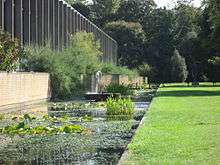 A view of the water garden along the west side of the site, toward the small bridge that was part of the original entrance sequence.
A view of the water garden along the west side of the site, toward the small bridge that was part of the original entrance sequence.- A view of the west-side accommodation and water garden.
 View of west-side accommodation from far-end of college, facing in the direction of the Porter's Lodge.
View of west-side accommodation from far-end of college, facing in the direction of the Porter's Lodge. View of west-side accommodation in winter, facing the 'Achaean'.
View of west-side accommodation in winter, facing the 'Achaean'.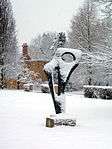 The statue outside the old porter's lodge in snow, "Achaean" by Barbara Hepworth.
The statue outside the old porter's lodge in snow, "Achaean" by Barbara Hepworth. Barbara Hepworth's "Achaean" at St Catherine's College, Oxford.
Barbara Hepworth's "Achaean" at St Catherine's College, Oxford. Dining Hall of St Catherine's College, Oxford
Dining Hall of St Catherine's College, Oxford.jpg) Architectural detail showing portion of the Bell Tower and Old Quad accommodation.
Architectural detail showing portion of the Bell Tower and Old Quad accommodation.- St Catherine's College Music House.
- St Catherine's College grade-listed bike shed.
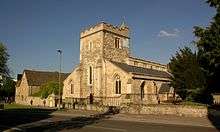 View of St Cross Church at entrance of St Catherine's College.
View of St Cross Church at entrance of St Catherine's College.
References
- "Student numbers". University of Oxford. December 2018. Retrieved 1 June 2020.
- "St Catherine's College : Financial Statements : Year ended 31 July 2019" (PDF). ox.ac.uk. p. 22. Retrieved 1 June 2020.
- "About Us". St Catherine's College. Retrieved 30 July 2019.
- "Student numbers | University of Oxford". www.ox.ac.uk. Retrieved 30 July 2019.
- "Women Making History | University of Oxford". www.ox.ac.uk. Retrieved 2 July 2020.
- Stat. Tit. II. Sect. II. Cl. I Addenda ad Corpus Statutorum Universitatis Oxoniensis p.754 https://books.google.co.uk/books?id=wT0JAAAAQAAJ&pg=PA754#v=onepage&q=nisi%20qui%20in%20aliquod%20collegium&f=false
- "College History". St Catherine's College, Oxford. Retrieved 19 January 2018.
- "College History". St Catherine's College. Retrieved 1 June 2020.
- Sivachelvam, Saranja (10 September 2012). "Fifty years of St Catz". The Oxford Student. Retrieved 6 June 2020.
- Trotman, R.R. & Garrett, E.J.K. The Non-Collegiate Students and St Catherine’s Society 1868–1962 (Oxford University Press, 1962)
- Report of the Delegati ad aedes licentiandas, (Oxford, June 1869)p.6-7
- Bullock, Alan (2000). "7 'A Scotch University added to Oxford'? The Non-Collegiate Students". In Brock, M. G.; Cuthoys, M. C. (eds.). Nineteenth-century Oxford. Part 2. The history of the University of Oxford. 7. p. 207. ISBN 9780199510177.
- http://www.oxfordhistory.org.uk/broad/buildings/east/hertford/29.html. Retrieved 19/01/18
- "College History". St. Catherine's College, Oxford website. Archived from the original on 9 November 2006. Retrieved 13 May 2007.
- "Women at Oxford". University of Oxford. Retrieved 12 June 2016.
- "Listed Buildings Online – St Catherines College, Podium And All Buildings Upon It". Heritage Gateway. Retrieved 16 September 2008.
- "Buildings and Grounds – www.stcatz.ox.ac.uk". University of Oxford. Retrieved 3 April 2018.
- "Library & IT". St Catherine's College. Retrieved 3 June 2020.
- "Bodleian Libraries | Libraries". www.bodleian.ox.ac.uk. Retrieved 3 June 2020.
- Dunton2017-10-17T06:00:00+01:00, Jim. "Purcell gets go-ahead for St Catherine's College expansion". Building Design. Retrieved 4 June 2020.
- "Ainsworth Graduate Centre Open for Students". St Catherine's College. 13 March 2020. Retrieved 4 June 2020.
- "St Catherine's College | University of Oxford". www.ox.ac.uk. Retrieved 22 February 2020.
- "Freshers' Guides". St Catz JCR. Retrieved 4 June 2020.
- St Catherine's College Freshers' Guide 2018, pg 8-20.
- Griffith, Rachael (30 October 2015). "Catz JCR make Chris Tarrant honorary member". Cherwell. Retrieved 6 June 2020.
- Darrah, Kim (7 June 2015). "St. Catz grant JCR financial independence". Cherwell. Retrieved 6 June 2020.
- "Catz MCR – The community of graduates at St. Catherine's College, Oxford". Retrieved 4 June 2020.
- St Catherine's College MCR Handbook 2015, section 3.
- Turner, Camilla; Ritchie, Greg (24 January 2019). "Oxford College abandons tradition of standing to address dons at formal dinners". The Telegraph. ISSN 0307-1235. Retrieved 30 July 2019.
- "St Catherine's College - Oxford University Alternative Prospectus". apply.oxfordsu.org. Retrieved 3 June 2020.
- "St Catherine's College | University of Oxford". www.ox.ac.uk. Retrieved 22 February 2020.
- Howe, Abigail (26 February 2020). "Preview: RENT". Cherwell. Retrieved 6 June 2020.
- Dorrell, Phil (14 February 2013). "St Catz declare war on Magdalen". The Oxford Student. Retrieved 6 June 2020.
- "St Catherine's College | University of Oxford". www.ox.ac.uk. Retrieved 22 February 2020.
- "Undergraduate Degree Classifications | University of Oxford". www.ox.ac.uk. Retrieved 22 February 2020.
- "2018 Finalists in Historic Norrington Table Success". St Catherine's College. 21 August 2018. Retrieved 4 June 2020.
- Ashworth, James. "St John's Tops The 2018 Norrington Table". The Oxford Student. The Oxford Student. Retrieved 20 August 2018.
- tomjoy. "Wallace Watson Award". Wallace Watson Award. Retrieved 3 June 2020.
- "Prizes & Awards". St Catherine's College. Retrieved 3 June 2020.
- "The Catalyst Programme". St Catherine's College. Retrieved 4 June 2020.
- "Outreach". St Catherine's College. Retrieved 4 June 2020.
- "'Lovelace' College | Facebook". www.facebook.com. Retrieved 1 June 2020.
- "St Catherine's College". danish design review. Retrieved 1 June 2020.
- Ko, Julianna (6 March 2014). "St Catz takes centre stage in new TV pilot". The Oxford Student. Retrieved 6 June 2020.
- "Here's why there were film crews in central Oxford yesterday". Oxford Mail. Retrieved 1 June 2020.
- "St Catherine's Society". british-history.ac.uk. Retrieved 11 December 2018.
- "Professor Peter Battle elected Pro-Master". St Catherine's College, Oxford. Retrieved 28 March 2019.
- "Professor Kersti Börjars Appointed as New Master". St Catherine's College, Oxford. Retrieved 19 June 2019.
- "Deborah Warner CBE named as Cameron Mackintosh Visiting Professor of Contemporary Theatre at Oxford 2019. | University of Oxford". www.ox.ac.uk. Retrieved 1 June 2020.
- Davies, M. & D. Creating St Catherine's College. Oxford: St Catherine's College, 1997. ISBN 0-9531279-0-7.
External links
| Wikimedia Commons has media related to St Catherine's College, Oxford. |
